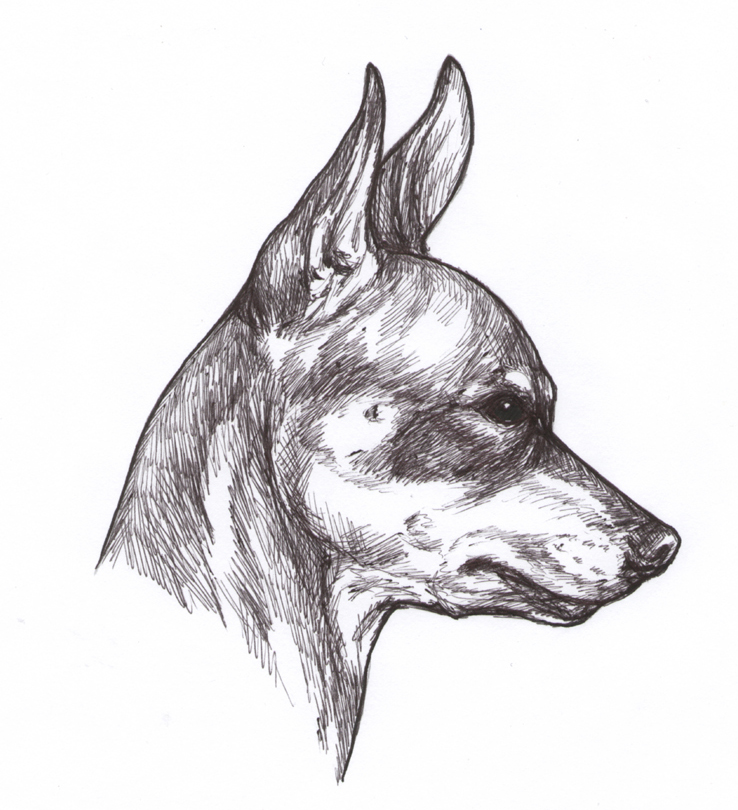Prague Ratter History
WILL THE GLORY OF THE PRAŽSKÝ KRYSARÍK (PRAGUE RATTER) BE REVIVED?
This was the title of an article published by the late editor-in-chief of the PES (The Dog) magazine Karel Stepansky which called on all Czech cynologists to help to revive the popular historical breed, the PRAGUE RATTER (PRAZSKY KRYSARIK) which used to grace the royal palaces in the Middle Ages. This appeal, published on page 6 in the sixth issue of the above mentioned magazine, did not remain unanswered. Today the Prague Ratter is with us again!
As cultural, social and economic conditions change, opinions, tastes and fashions change as well. These changes are also reflected in the development and popularity of different breeds of dogs. The interest in some breeds grows and then diminishes or disappears, only to grow again after a short or long (sometimes very long) period of time. The Prague Ratter is such a breed. Though never internationally recognized it once enjoyed immense popularity and then became almost completely forgotten. No wonder that questions were being raised as to why Czech cynologists, who rank among the world leaders, had not preserved this purely Czech breed which can be traced back to the early history of the Czech lands (historically referred to as Bohemia).
It is never too late - as the saying goes. Those who made the decision to revive this breed faced a very difficult task and considered it very carefully and for a very long time. They studied some articles of the late, once well known cynologists such as Otto Karlik, Theodor Rotter, vet Frantisek Dvoracek and many others which had been published in specialist journals and cynological periodicals in the 1920s, 1930s and later years. They also studied information gathered by the popular science publicist Emil Jech from Roztoky near Prague. It was he who had discovered and confirmed the existence of the Prague Ratter and brought forward indisputable evidence that this breed was around during Bohemian Prince Vladislav II's time.
As the breed is really so old, it is practically impossible to trace its early beginnings. However, Polish chronicler Galla Anonym wrote that Polish King Boleslav II the Generous (1058 -1080) became fond of the Ratter. He had two that came from Bohemia (the Czech lands). The chronicle says: "Not only Polish blood but also purely Slavonic blood, donated blood, circulates in the veins of our dogs". As the king of Poland valued this gift, we can presume that it was a royal gift from prince Vladislav II. The French historian Jules Michelet mentioned in his work "Histoire de France" three ratting dogs came from the Czech lands. He clearly talks about a living gift, Prague Ratters, which the Czech king Karel IV (who also bore the title of Emperor of Rome) presented to the French king Charles V during his visit to France in the autumn of 1377. In early September of 1380 the dying Charles V bequeathed two of these dogs to his twelve-year-old son Charles VI.
The story goes that King Vaclav IV (1378 - 1419) used to take his favourite Ratter to the "U krale Brabantskeho" pub which he liked to frequent in disguise. In his works Professor Weise cogitates about the past centuries and pays particular attention to the reign of emperor Rudolf II. Quote: "Rudolf II (1576 - 1611) always found comfort and clear mind amidst his hounds and ratters. The original four ratters bred and the numbers increased to eighteen. This was an excellent example of his breeding efforts". The Ratter was often present at royal banquets. This small dog also symbolized the independence of Czech lands (Bohemia) and sovereignty of the Czech nation. From the early history of the Czech lands (Bohemia) the Ratter adorned the courts of Czech princes and kings and was often given as a gift to other European rulers. From the royal palaces it then spread to other strata of society.
The tragic defeat at the battle of the White Mountain resulted in the decline of Czech political, cultural and social life for three centuries. This period in Czech history also meant the departure from glory for the Prague Ratter. The Prague castle (the seat of Czech rulers) started to lose its significance and the Ratter began to leave the confines of the castle walls to live amongst ordinary folk.
The breed has survived to the present day. By a twist of fate the dogs that typified the breed were disqualified at dog shows. They were judged to be 'atypical' and too small. The judges were using a standard for miniature pinschers - a similar looking German breed. So once again the krysarík was pushed into the background which was detrimental to its further development. Leading canine experts such as Theodor Rotter and Otakar Karlik took an interest in these atypical, smooth-haired pinschers and attempted to set up a breeding programme and gather documentation. They failed because the chosen dogs did not have the six generation pedigree which was, at that time, a requisite for registration.
At the same time, in neighbouring Germany, Adolf Hitler was rising to power and in 1938 he invaded the Czechoslovak Republic. In the 1950s Theodor Rotter lost all his property including all his paperwork relating to the Ratter. The will to revive the breed had also gone. In the 1980s the attempt to revive the breed was repeated and finally succeeded. The Prague Ratter is here to stay.
The Prague Ratter has an old tradition so today we have a duty to ensure its survival in the future.
** This information was gleaned from www.prazsky-krysarik.cz
